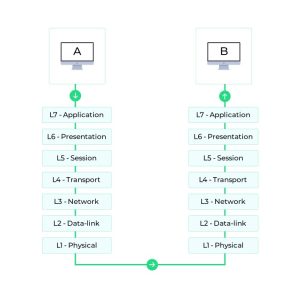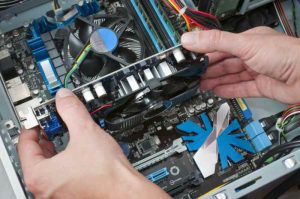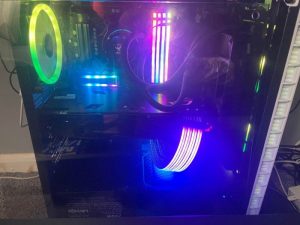
Dive into the fascinating realm of IoT and data communication where devices talk to each other in a digital dance of connectivity and information exchange. Get ready to unravel the secrets behind this technological marvel!
IoT and Data Communication
IoT, or Internet of Things, refers to a network of interconnected devices that can communicate and share data with each other over the internet. This concept has revolutionized the way we interact with technology and has become an integral part of our daily lives.Data communication plays a crucial role in enabling IoT devices to connect and exchange information securely and efficiently.
It involves the transmission of data between devices using various communication protocols, ensuring that the information is delivered accurately and in a timely manner.
Role of Communication Protocols in IoT
Communication protocols such as MQTT, CoAP, and HTTP are utilized by IoT devices to transmit data over networks. These protocols define the rules and conventions for communication, ensuring that devices can understand each other and exchange information seamlessly.
- MQTT (Message Queuing Telemetry Transport) is commonly used for IoT applications due to its lightweight and efficient nature. It enables devices to publish and subscribe to topics, facilitating real-time communication.
- CoAP (Constrained Application Protocol) is designed for resource-constrained devices in IoT networks. It allows for efficient communication over UDP, reducing latency and bandwidth usage.
- HTTP (Hypertext Transfer Protocol) is widely used for web communication and is also employed in IoT applications for accessing data from web servers and APIs.
Real-World Applications of IoT and Data Communication
IoT and data communication intersect in various industries and applications, transforming processes and improving efficiency. Examples include:
- Smart Home Systems: IoT devices such as smart thermostats, lights, and security cameras communicate over networks to provide homeowners with remote control and automation capabilities.
- Industrial Internet of Things (IIoT): Manufacturing plants utilize IoT sensors and devices to monitor equipment, optimize production processes, and enable predictive maintenance through data communication.
- Healthcare Monitoring: Wearable devices and medical sensors transmit real-time health data to healthcare providers, enabling remote monitoring and timely interventions for patients.
Electronics and Electrical
In the realm of IoT, the synergy between electronics, electrical systems, and data communication plays a crucial role in enabling seamless connectivity and efficient information exchange among devices.
Relationship Between Electronics, Electrical Systems, and Data Communication
Electronics form the foundation of IoT devices, encompassing components like sensors, microcontrollers, and actuators that collect, process, and transmit data. Electrical systems provide the power necessary to operate these devices and ensure continuous communication within IoT networks.
Facilitation of Data Transmission by Electrical Components
Electrical components such as transmitters, receivers, and antennas facilitate data transmission in IoT networks by converting data into electrical signals, transmitting them wirelessly or through wired connections, and ensuring reliable communication between interconnected devices.
Impact of Advancements in Electronics on Data Communication Efficiency
Advancements in electronics, including miniaturization, increased processing power, and improved energy efficiency, have significantly enhanced data communication efficiency in IoT ecosystems. These advancements enable faster data processing, reduced power consumption, and enhanced connectivity, leading to more responsive and reliable IoT applications.
Application of Electrical Engineering Principles in IoT Device Design
Electrical engineering principles are fundamental in designing IoT devices for seamless data communication. Concepts such as circuit design, signal processing, power management, and electromagnetic compatibility are crucial in ensuring the reliability, performance, and interoperability of IoT devices in diverse environments.
Computer Repair and Consulting
Computer repair services play a crucial role in maintaining IoT devices to ensure uninterrupted data communication. These services help troubleshoot issues, perform regular maintenance, and optimize device performance.
Common Data Communication Issues in IoT Systems and Solutions
- Interference and Connectivity Problems: Computer repair specialists diagnose and resolve issues related to signal interference, weak connections, or network disruptions.
- Security Vulnerabilities: They implement security measures such as encryption, firewalls, and regular software updates to protect IoT devices from cyber threats.
- Data Loss and Corruption: Specialists backup data regularly, recover lost data, and ensure data integrity to prevent information loss in IoT systems.
- Compatibility and Integration Challenges: They ensure that different IoT devices and systems can communicate effectively by resolving compatibility issues and optimizing integration.
Best Practices for Consulting on Data Communication Strategies for IoT Optimization
- Conducting a Comprehensive Assessment: Analyzing the current data communication infrastructure, identifying bottlenecks, and recommending solutions for optimization.
- Implementing Redundancy Measures: Setting up backup systems, data storage solutions, and failover mechanisms to ensure data continuity in case of failures.
- Regular Monitoring and Maintenance: Providing ongoing monitoring, maintenance, and updates to optimize IoT device performance and prevent potential issues.
Examples of Computer Repair and Consulting Contributions in Enhancing Data Communication in IoT Environments
- Resolving Network Congestion: Computer repair specialists optimize network configurations and remove bottlenecks to improve data flow in IoT systems.
- Securing IoT Devices: Consulting services implement robust security protocols and encryption methods to protect data transmitted between IoT devices.
- Improving System Integration: Specialists facilitate seamless integration between different IoT devices and platforms to enhance overall data communication efficiency.
Data Communication

Data communication plays a vital role in the functioning of IoT networks by enabling the transfer of information between devices and systems. It allows IoT devices to collect and share data, facilitating real-time monitoring, control, and decision-making processes.
Methods and Technologies for Data Communication in IoT
- Wired Communication: Utilizes physical cables to establish connections between devices, offering reliable and secure data transfer.
- Wireless Communication: Enables data transmission over radio frequencies, using technologies like Wi-Fi, Bluetooth, Zigbee, and LoRa for seamless connectivity.
- Cellular Communication: Leveraging cellular networks such as 3G, 4G, and upcoming 5G for IoT applications requiring broader coverage and mobility.
Comparison of Data Communication Protocols in IoT
- MQTT (Message Queuing Telemetry Transport): Lightweight protocol ideal for low-bandwidth, high-latency networks, ensuring efficient data transfer.
- HTTP (Hypertext Transfer Protocol): Commonly used for web-based communication, offering simplicity but may not be suitable for resource-constrained IoT devices.
- CoAP (Constrained Application Protocol): Designed for IoT applications, providing low overhead and efficient data transfer, suitable for constrained devices.
Impact of Data Communication Standards on IoT Ecosystems
Data communication standards play a crucial role in ensuring interoperability and scalability within IoT ecosystems. By establishing common protocols and formats for data exchange, standards facilitate seamless integration of diverse devices and systems, enabling efficient communication and collaboration. Additionally, adherence to standards promotes compatibility, simplifies deployment, and enhances the overall reliability and security of IoT networks.
Computers E-Books

E-books on computers play a crucial role in covering topics related to IoT and data communication. These digital resources provide in-depth knowledge, practical examples, and insights into the integration of IoT technologies with data communication principles.
Integration of IoT with Data Communication
- One example of an e-book that delves into the integration of IoT with data communication is “Internet of Things: Principles and Paradigms” by Rajkumar Buyya, Amir Vahid Dastjerdi, and Peter D. Pham. This book explores the fundamental concepts of IoT and its connection with data communication protocols.
- Another e-book, “IoT Fundamentals: Networking Technologies, Protocols, and Use Cases for the Internet of Things” by David Hanes and Gonzalo Salgueiro, provides a comprehensive overview of how IoT devices communicate over networks and the role of data communication in enabling IoT applications.
Educational Contribution of E-Books
- E-books contribute significantly to educating readers on the latest trends and developments in IoT data communication by offering up-to-date information, case studies, and best practices.
- Readers can access e-books to deepen their understanding of emerging technologies, protocols, and standards shaping the landscape of IoT and data communication.
Benefits of Accessing E-Books
- Accessing e-books on computer-related subjects like IoT and data communication allows individuals to expand their knowledge base conveniently and at their own pace.
- E-books offer a cost-effective and easily accessible way to stay informed about advancements in IoT technologies, data communication protocols, and industry trends.
Graphics and Multimedia
Graphics and multimedia play a crucial role in simplifying complex concepts related to IoT and data communication. By visually representing intricate processes, these elements enhance understanding and engagement among learners and professionals in the field.
Role of Graphics and Multimedia in IoT and Data Communication
- Visual representations help in illustrating the interconnectedness between IoT devices and data communication networks. For example, diagrams showing how sensors collect data and transmit it through a network can make the process more comprehensible.
- Multimedia resources such as videos, animations, and interactive simulations can provide a dynamic and engaging way to showcase how data is transferred between devices in an IoT system.
- By incorporating graphics and multimedia elements in educational materials about IoT and data communication, educators can cater to different learning styles and enhance retention of information.
Computers Hardware
In the realm of IoT and data communication, the hardware components play a crucial role in enabling seamless and efficient transmission of data between devices. Let’s delve into the key aspects of computer hardware in supporting data communication within IoT systems.
Essential Hardware Components for IoT Data Communication
- Microcontrollers: These are the brain of IoT devices, responsible for processing data and executing commands.
- Wireless Modules: Components like Wi-Fi, Bluetooth, and Zigbee modules enable wireless connectivity for data exchange.
- Sensors: Various sensors such as temperature, humidity, and motion sensors collect real-time data for transmission.
- Memory: Both volatile (RAM) and non-volatile (ROM) memory are essential for storing and retrieving data during communication.
- Power Supply: Stable power sources like batteries or power modules are critical for uninterrupted data transmission.
Evolution of Computer Hardware for IoT Support
- Miniaturization: Hardware components have become smaller and more energy-efficient to fit into compact IoT devices.
- Increased Processing Power: Advanced processors and microcontrollers can handle complex data processing tasks in real-time.
- Enhanced Connectivity: The integration of multiple wireless protocols has expanded the connectivity options for IoT devices.
- Improved Energy Efficiency: Hardware designs now focus on minimizing power consumption for prolonged device operation.
Advancements in Hardware Technology for Data Transmission
- High-Speed Connectivity: Latest hardware supports faster data transfer rates, reducing latency in IoT communication.
- Security Features: Hardware advancements include robust encryption and authentication mechanisms to ensure data integrity and confidentiality.
- Scalability: Modern hardware architectures are designed to scale with the increasing data demands of IoT ecosystems.
Role of Hardware Compatibility in IoT Data Communication
- Interoperability: Compatible hardware components allow different IoT devices to communicate seamlessly, fostering a cohesive network.
- Standardization: Adherence to industry standards ensures that hardware from different manufacturers can work together harmoniously.
- Reliability: Hardware compatibility plays a vital role in maintaining stable data transmission and minimizing communication errors.
Closing Summary
As we wrap up our journey through the intricate web of IoT and data communication, remember that these technologies are the backbone of our connected future, paving the way for endless possibilities and innovations. Stay curious, stay connected!
Query Resolution
How does IoT enhance data communication?
IoT enables devices to communicate and share data seamlessly, revolutionizing the way information is transmitted and processed.
What are some common communication protocols used in IoT?
Popular protocols like MQTT, CoAP, and HTTP are often employed in IoT devices for efficient data transfer.
How can computer repair services improve IoT data communication?
Computer repair specialists troubleshoot and fix connectivity issues, ensuring smooth data flow in IoT networks.







